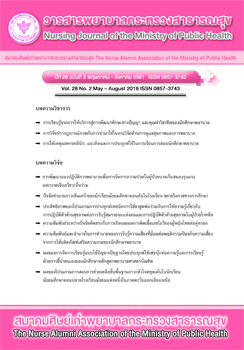Development of Nursing Practice Guidelines for Pain Management in Severe Traumatic Brain Injury and Multiple Injury Patients
Main Article Content
Abstract
Abstract
The development of nursing practice guidelines for pain management in severe traumatic brain injury and multiple injury patients employed the evidence-based practice model of Soukup in 2000 which consisted of 1) pain assessment, 2) pain management, and 3) prevention of risk factors of pain stimulating severity of pathology. The content validity was performed (CVI=.93). The practice guidelines was applied by 29 nurses in an accident and surgery department. The possibility of application, and satisfaction with the application of the guideline were assessed. It was found that 1) the possibility of application was good at 72.9 percent, 2) the satisfaction with the application was good at 86.5 percent, and 3) the satisfaction with the nursing practice regarding pain mangement with medicines and involvement with the practice development was good at 75.86 percent. The practice also gave the nurses confidence to perform their role independently in order to manage pain, which was good at 75.17 percent. The nursing practice followed the pain management practice guidline at 80 percent. The nurses were satisfied with the pain assessment applied with the patients who were not able to communicate, especially those who were unconscious and those whohad pain killer injection (12 patients). They were closely monitored for side effects of the medicines. application was good at 72.9 percent, 2) the satisfaction with the application was good at 86.5 percent, and 3) the satisfaction with the nursing practice regarding pain mangement with medicines and involvement with the practice development was good at 75.86 percent. The practice also gave the nurses confidence to perform their role independently in order to manage pain, which was good at 75.17 percent. The nursing practice followed the pain management practice guidline at 80 percent. The nurses were satisfied with the pain assessment applied with the patients who were not able to communicate, especially those who were unconscious and those whohad pain killer injection (12 patients). They were closely monitored for side effects of the medicines.
Article Details
บทความและรายงานวิจัยในวารสารพยาบาลกระทรวงสาธารณสุข เป็นความคิดเห็นของ ผู้เขียน มิใช่ของคณะผู้จัดทำ และมิใช่ความรับผิดชอบของสมาคมศิษย์เก่าพยาบาลกระทรวงสาธารณสุข ซึ่งสามารถนำไปอ้างอิงได้
References
1. Smeltzer SC, Bare BG, Hinkle JL,Cheever KH. Pain Management. Brunner&Suddarth’s Textbook of Medical-surgical Nursing 12thed 2010.
2. Ahmadi A, Shahrzad BH, Zahra HZ, EuasobhonP. Ketumarn P, Karbasfrushan A, et al. Pain management in trauma: A review study. Journal Injury Violence Respiratory 2016;8(2):89-98.
3. Bussamongkon N, Paerkoa C. The relationship between severity of injuries and nursing outcomes in injured patients. Journal of Nursing and Health Care 2017:110-8. (in Thai)
4. Haddad SH, Arabi YM. Critical care management of severe traumatic brain injury in adults. Scandinavian Journal of Trauma: Resuscitation and Emergency Medicine 2012;20(12):2-15.
5. Deepak G, DeepakS, Kannan N, Prapruettham S, Charles M, Wang J,et al. Guideline Adherence and Outcome in severe Adult: Traumatic Brain Injury for the CHIRAG Study (Collaborative Head Injury and Guide lines). World Neurosurgery: Traumatic Brain Injury Guideline[Internet]. 2016[cited 2017 November 10];89:169-79. Available from:www.ncbi.nlm.nih.gov/pubmed/26806065
6. Liao Kh, Chang CK, Chang KC, Chen TY, Chou CW, Chung WY, et all. Clinical practice guidelines in severe traumatic brain injury in Taiwan. World Surgical Neurology. 2009;72(2): 66-74. doi:https://doi.org/10.1016/j.surneu.2009.07.004
7. Lannin NA, Laver K, Henry K, Turnbull M, Elder M, Campisi J,et al.Effects of care management after brain injury : A systematic review. Neuro Rehabilitation Journal 2014;35(4):635-41. doi: 10.3233/NRE-141161
8. Schnaker C, Chatelle C, GosseriesS.MO, Marie DV, Laureys S. Assessment and detection of pain in non communicative severely brain injured patients. Expert review of Nuerotherapeutics 2010;10(11) :1725-31.
9. Stocchetti N, Carbonara M, Citerio G,Ercole A,Skrifvars MB,SmielewskiP, et al. Severe traumatic brain injury:targeted management in the intensive care unit. The LANCET Neurology 2017;16(6):452-64
10. Barr J, Ely EW, Davidson JE, Joffe AM, Ramsay MA, Brenda P.Clinical Practice Guidelines for the Management of Pain, Agitation, and Delirium in Adult Patients in the Intensive Care Unit. Critical Care Medicine2013;41(1):263-306. Available from http://www.iculiberation.org/Bundles/Pages/Pain.aspx.
11. Arbour C, Gelinas C. Behavioral and Physiologic Indicatiors of pain in nonverbal patients with a traumatic Brain Injury : An integrative review. Pain Management Nursing 2014;15(2):506-18.
12. Hickey JA, March KS. Head injury and Dysfunction. Advanced Critical Care Nursing 2nd ed chapter 12.American Association of Critical Care Nurse 2014;218-35
13. Ngamkham S, Krutchan N, Sawangchai J, Wattanakul B, Chidnayee S, Kiecha R. Knowledge about pain assessment and management of Thai Nurses. Journal of Nursing and Health Care. 2018;36(1):81-89. (in Thai)
14. British Pain Society Published. Guidelines for Pain Management Programmes for adults : An evidence-based review prepared on behalf of the British Pain Society. London [internet]. 2013[cited 2016 November 10]. Available from : http://www.british pain society.org
15. Luaute J, Plantier D, Wiart L, Tell L, SOFMER group. Care management of the agitation or aggressiveness crisis in patients with TBI: Systematic review of the literature and practice recommendations. Annals of Physical and Rehabilitation Medicine 2016;59(1):58–67.
16. Jumpamool A. The Outcomes Model for Health Care Research : management in injury and emergency patients. Handout Khon Khan University 2015. (in Thai)
17. Soukup M. The center of advanced nursing practice evidence-based practice model :Promoting the scholarship of practice [Internet]. Nursing Clinic of North America 2000 [cited 2017 Nov 21];35(2),301-9.Available from:ttps://books.google.co.th/books? isbn=0826123139
18. Joanna Briggs Institute. Reviewers’ Manual 2014 Edition. Australia: Solito Fine Colour Printers. 2014 [cited 2016 May 1]Available from :http: www.joannabriggs.org/ assets/docs/
19. Techaatik P, Wunsupon S, Sumritrin S. Effectiveness of implementing Evidence-Based Practice for Traumatic Patients at Out Patient of the Accident and Emergency Unit. Journal of Nursing Science & Health 2011;34(3): 65-74. (in Thai)
20. Vongrabilnam K. Development and Evaluation of clinical nursing practice guideline for pain management in elderly trauma patients[Master thesis]. Songkla: Songkla University. 2013.(in Thai)

